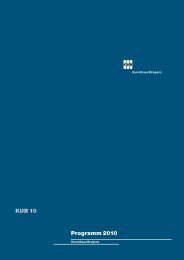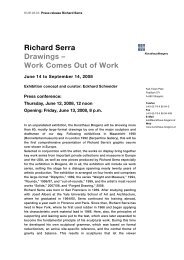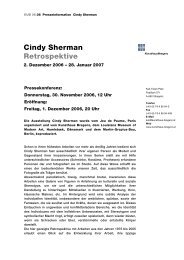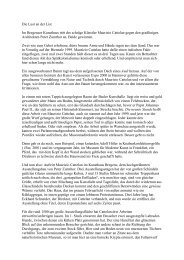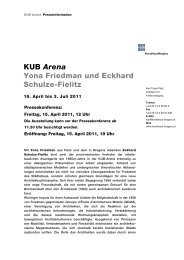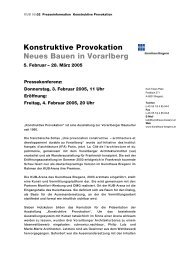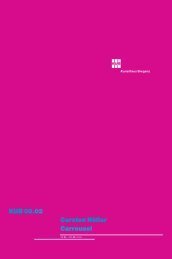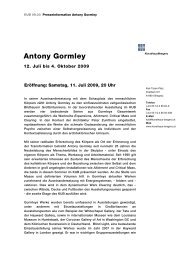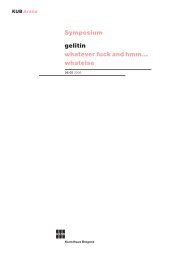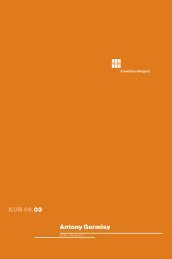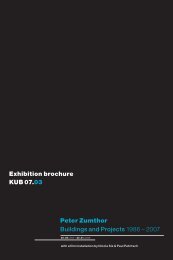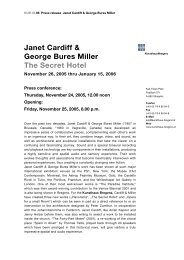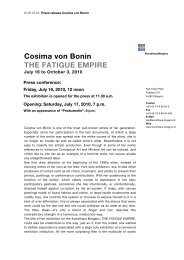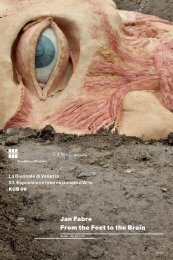KUB 08.03 Richard Serra Drawings Work Comes Out of Work
KUB 08.03 Richard Serra Drawings Work Comes Out of Work
KUB 08.03 Richard Serra Drawings Work Comes Out of Work
Erfolgreiche ePaper selbst erstellen
Machen Sie aus Ihren PDF Publikationen ein blätterbares Flipbook mit unserer einzigartigen Google optimierten e-Paper Software.
<strong>Richard</strong> <strong>Serra</strong><br />
Solid #8 | 2008<br />
Ölkreide auf handgeschöpftem Papier<br />
101,6 x 101,6 cm<br />
Sammlung des Künstlers<br />
Foto: Rob McKeever<br />
<strong>Serra</strong>’s drawing material is the paintstick, a wax-like grease crayon.<br />
<strong>Serra</strong> melts several paintsticks to form large pigment blocks. This<br />
transformation allows him to apply the material in broad, dense<br />
strokes. He applies it either directly onto the paper with large<br />
sweeps <strong>of</strong> his arm, or he uses a window-screen as an intermediar y<br />
surface through which he presses the color. In his recent “Solids,”<br />
<strong>Richard</strong> <strong>Serra</strong> goes a step further: “Melted paintstick is poured<br />
onto a hard surface on the floor. Sometimes, not always, a sheet <strong>of</strong><br />
window-screen is placed on top <strong>of</strong> the liquid paintstick. Then the<br />
paper is laid down, either on top <strong>of</strong> the screen or directly on top <strong>of</strong><br />
the liquid paintstick. Pressure is exerted on the back <strong>of</strong> the paper<br />
with a hard marking tool. The front side <strong>of</strong> the paper picks up the<br />
mark. With a few exceptions where the front is marked through a<br />
blackened screen, no direct drawing is done on the front <strong>of</strong> the<br />
paper. I don’t see the drawing I am making until the paper is pulled<br />
<strong>of</strong>f the floor and turned over or the screen is lifted.”<br />
For the series “Weight and Measure,” <strong>Richard</strong> <strong>Serra</strong> has<br />
brought together two large sheets <strong>of</strong> double-laminated Hiromi<br />
paper. He treats each <strong>of</strong> the two as an active substance rather than<br />
a passive ground by positioning the upper sheet so that it only very<br />
slightly overlaps with the lower one. Together with the black areas<br />
applied as layers <strong>of</strong> paintstick, these drawings, like the “Diptychs,”<br />
are reminiscent <strong>of</strong> the balancing <strong>of</strong> metal slabs with space, weight,<br />
equilibrium, size, scale, placing, and density.<br />
The series “Rounds” and “out-<strong>of</strong>-rounds” result from the<br />
application <strong>of</strong> material in an exhausting process, which gives the<br />
forms material presence, mass, and weight. In “out-<strong>of</strong>-rounds,” a<br />
curved cardboard shape marks the circumference and defines the<br />
paintstick borders during application. Liquid material under pressure<br />
shoots out and produces the explosive markings at the edges.<br />
Characteristic for <strong>Richard</strong> <strong>Serra</strong>’s drawings is the fact that he produces<br />
them as series.<br />
With his “Forged Drawing,” created especially for the <strong>KUB</strong>,<br />
<strong>Serra</strong> picks up on a work series from the 70s and 80s. It deals with<br />
steel masses in each <strong>of</strong> the four basic shapes that can be forged<br />
with a blacksmith’s hammer: circle, rectangle,octagon, and square.<br />
“These are the building blocks which most forged products can be<br />
traced back to. I thought it would be worth the effort to point out<br />
that […] they are the graphic elements from which everything a<br />
blacksmith forges derives. I interpreted this literally and re-presented<br />
this idea by hanging the steel forms on the wall and covering<br />
their surfaces with a paintstick.”<br />
<strong>Serra</strong>’s programmatic drawing concept <strong>of</strong> connecting<br />
body awareness with material and integrating both visual and<br />
tactile perception allows the viewer to experience a densified,<br />
intensified space in connection with densified, materialized time.<br />
Eckhard Schneider



